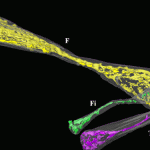
Neutron imaging of delicate fossils reveals what an ancient crocodile had for dinner.
The Australian Age of Dinosaurs Museum has announced the discovery of Confractosuchus sauroktonos, a new genus and species of ancient crocodile, found on the Winton sheep station in Queensland where major fossil finds led to the museum’s foundation in 2002.
The fossilised crocodile was too fragile for the surrounding rock to be removed conventionally, so the fossil was placed in the care of Dr Joseph Bevitt, a Senior Instrument Scientist at ANSTO. He used the neutron imaging station at Lucas Heights in NSW Australia for non-destructive X-ray micro-CT scanning technologies, identifying where the bones were located.
Still more excitement came with the discovery of tiny dinosaur bones in the crocodile’s gut – the first time in the world a crocodile has been discovered with dinosaur remains in its stomach.
“We had discovered a dinosaur using neutrons for the first time!” enthuses Dr Bevitt.
An exact classification hasn’t been possible from the remains, but it is thought to be a juvenile ornithopod dinosaur weighing up to 1.7kg, with indications that the Confractosuchus either directly killed it or scavenged it quickly after its death, some 95 million years ago in the Late Cretaceous Period.






